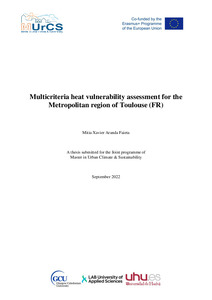Multicriteria heat vulnerability assessment for the metropolitan region of Toulouse (FR)
Aranda Faieta, Mitia Xavier (2022)
Aranda Faieta, Mitia Xavier
2022
All rights reserved. This publication is copyrighted. You may download, display and print it for Your own personal use. Commercial use is prohibited.
Julkaisun pysyvä osoite on
https://urn.fi/URN:NBN:fi:amk-2022110622085
https://urn.fi/URN:NBN:fi:amk-2022110622085
Tiivistelmä
Based on key findings of the IPCC’s Sixth Assessment Report (AR6), “It is virtually certain that hot extremes (including heatwaves) have become more frequent and more intense across most land regions”. Within this context, better understanding the impact of urban heat has become increasingly relevant. This work aims at contributing to this research area by generating a urban heat vulnerability assessment combining environmental, socio-economic, and demographic data for the Metropolitan region of Toulouse (France). As part of its objectives, the study focuses on the potentials and limitations of composite indexes and heat vulnerability maps as operational tools for urban climate plans. Data collected from different sources (national mapping institute, national statistical institute, metropolitan authority open data repository, and urban weather station network) was employed to perfome a Cumulative Vulnerabilities Assessment (CVA), which assigns different levels of vulnerability to spatial units based on their values of Environmental, Socio-economic, and Susceptible Population scores. Results of the CVA were then crossed with other two heat vulnerability assessments’ results obtained from the application of a Principal Component Analysis (PCA) and an Analytical Hyerarchic Process (AHP). The combination of the results from the three methodologies was used to produce a combined heat vulnerability map. Results obtained highlighted hostspots of urban heat related vulnerability in the metropolitan region of Toulouse. Furthermore, the study found that composite indexes can be an effective tool to spatially visualize cumulative vulnerabilities tendency over the metropolitan region; however, they are not sufficient to support decision makers and practitioners in defining what type of intervention would be more appropriate over a specific area. In addition, the study suggests that statistically obtained findings should be accompanied by qualitative field research to complement, better characterize, and describe heat vulnerability.
